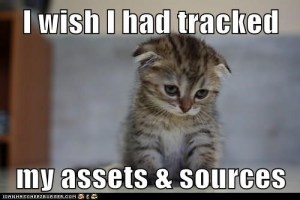This is the post for the Wednesday, April 8, 2015 class meeting.
Today, we will talk about gathering assets for your project and the expectations for your project pitches.
Planning for Project 4
You can check out the topics and requirements for the rest of the term by looking at the class calendar. Be sure to notice presentation sign-up day, peer feedback day, and presentation days. Also note the online work day scheduled for April 17.
Hunting and Gathering
For this project, you will need to find assets, like sound clips, video clips, photographs, cartoons, and so forth to include in your project.
 To start, we’ll talk about sources and assets.
To start, we’ll talk about sources and assets. - Be sure to consult Chapter 4 of Writer/Designer, which has lots of information on gathering resources, permissions and fair use, and tracking what you find.
- Make a copy of the Project 4 Source List Template and track your sources there. See the assignment on pp. 62–63 (“A Multimodal Annotated Source List, Part 1”) for the information to include in your annotations.
- Alternately, you can use your own system, like the Winnie the Pooh Sources blog entries. You might also clip info to Evernote or use a bookmarking service like Diigo.
NOTE: Finding assets is not a requirement for this week, but you will find it pays to keep track of possible assets that you find. Nothing is more frustrating than knowing that you saw something you could use and then not being able to find it again.
Choosing and Using Assets
I have posted tips for finding assets for your projects on the FAQ site. Here’s the short version:
Most importantly, know that unless you take the photo, record the audio, or film an event yourself, you need to be sure that it’s okay to use it in your writing. Remember that assets you make yourself can be simple. Take advantage of your own creativity. Anything you make, you can use freely. Consider the approaches of The Christmas Snake or Don Quixote and the Giants.
You will probably also incorporate assets that you have acquired, rather than created. Work through these FAQs for details and resources, including places to find assets that you can use freely (as long as you credit your source):
- How does copyright work with images?
- How do I choose images for my projects?
- How can I tell if an image is protected by copyright?
- Where can I find graphics that I can use in my projects?
- How do I use images in my project?
- Can I use this image if I link to the original?
Prepare Your Pitch
You will pitch your project to the class on Friday, April 10. As Writer/Designer defines it, “A pitch is a short presentation that explains how the what and the how of your idea might come together in the final project. . . . Pitches are sometimes called elevator speeches, drawing on the idea of a writer who is on an elevator with a publisher and has only four floors to convince the publisher to accept his or her book proposal” (55).
You will have about two minutes to tell the class the story you have chosen, how you are remixing it, what form/genre you are using, what tools you will use, and how are you incorporating risk. I will display those topics on the board/screen to help you make sure you cover everything. To prepare:
- See the list of questions on p. 56 of Writer/Designer.
- If you want even more tips, watch relevant portions of the Lynda.com tutorial on Pitching Projects and Products to Executives (free with your VT.edu login).
Writing and Homework
-
Today: Write a blog post that informally proposes the story you will focus on for your remix, or in the language of Chapter 3 of Writer/Designer, “the what” you will focus on. Include the following information:
- Tell us the story you have chosen.
- Explain what portion of the story, if relevant.
- Identify what genre you want to use for the project.
- Give us the bibliographic citations and/or links to at least three sources that you will use as you work on your project. You can use any bibliographic format you like, but be sure there’s enough information for me to confirm the sources.
-
Friday, 4/10: Be ready to give your pitch to the class, in short 2-minute max explanations, following the list of questions on p. 56 of Writer/Designer.
-
Monday, 4/13: We’ll go over tools, timelines, and the highlights of Chapter 5. Most of the class time will be spent working on the project.
-
Wednesday, 4/15: We’ll go over the highlights of Chapter 6, looking at mock-ups and storyboards. Most of the class time will be spent working on the project. I will ask you to declare the primary technologies you will use in a blog post.
-
Friday, 4/17: Class will work online. You will read about how to include documentation in your projects and the requirements for your presentations. You will continue working on your project and write a blog post.